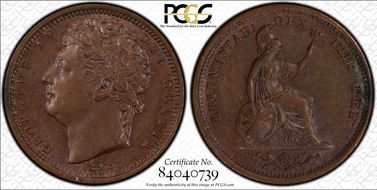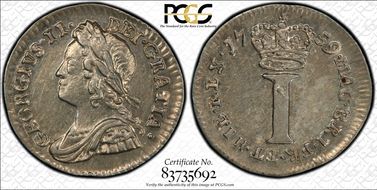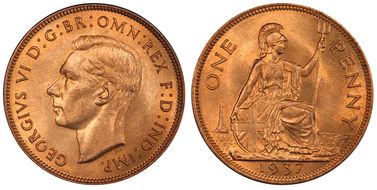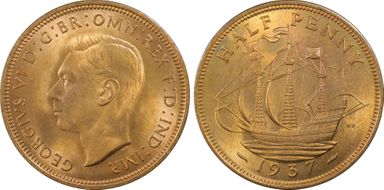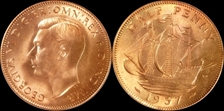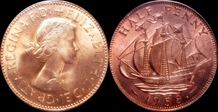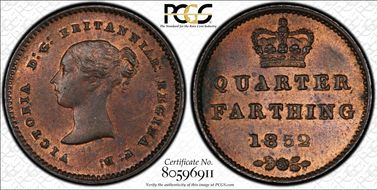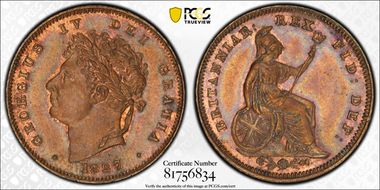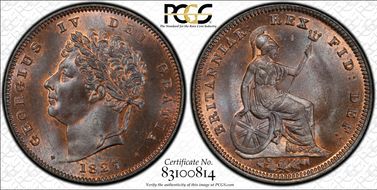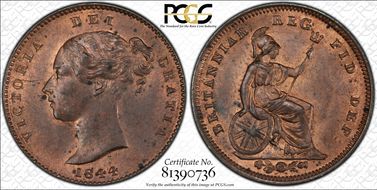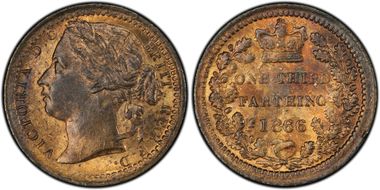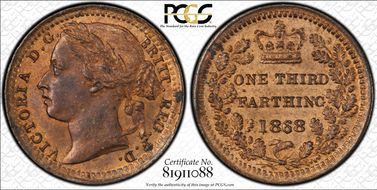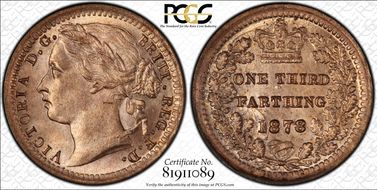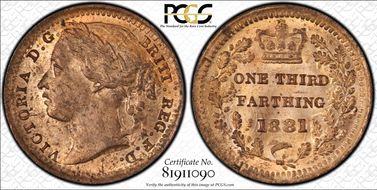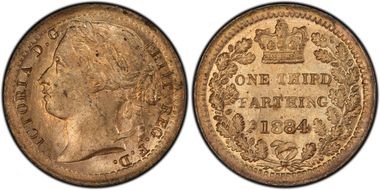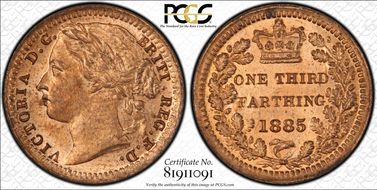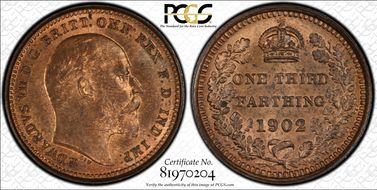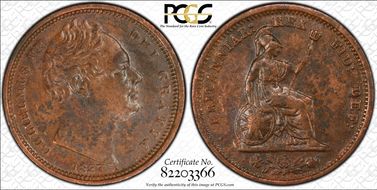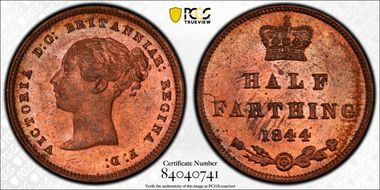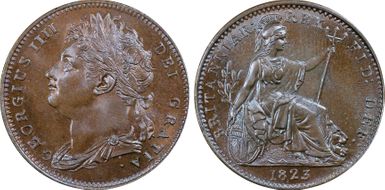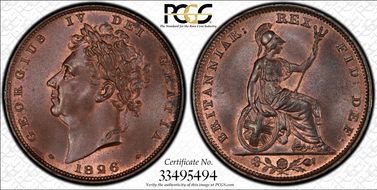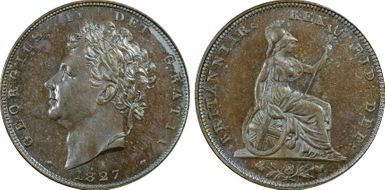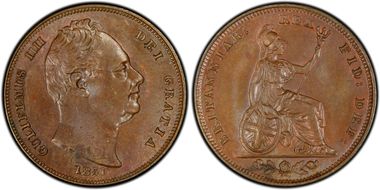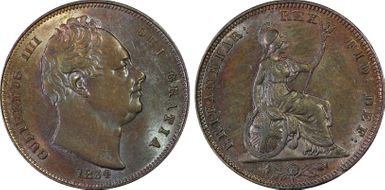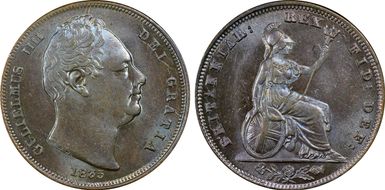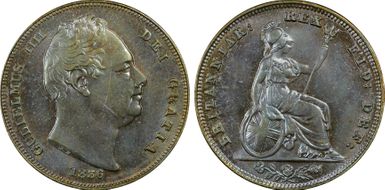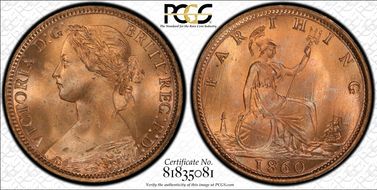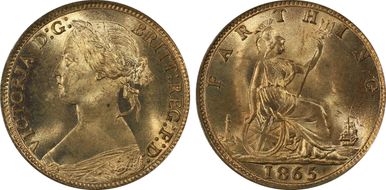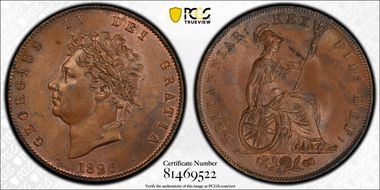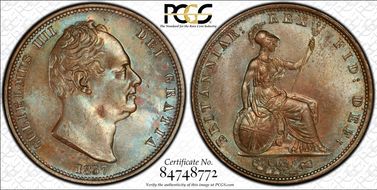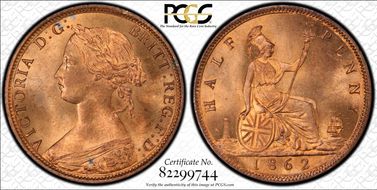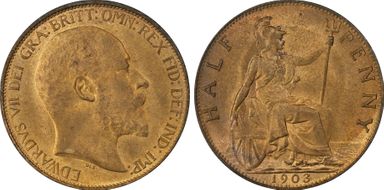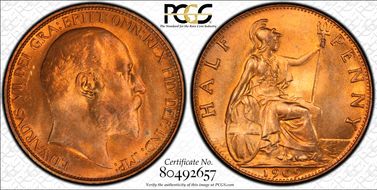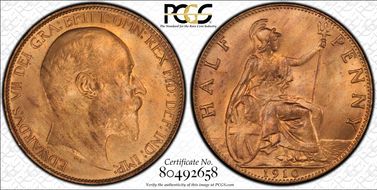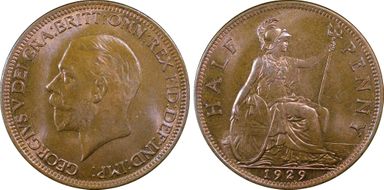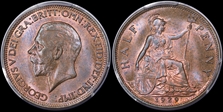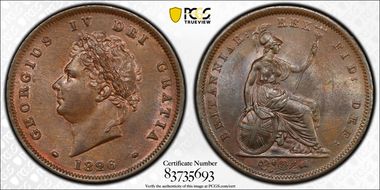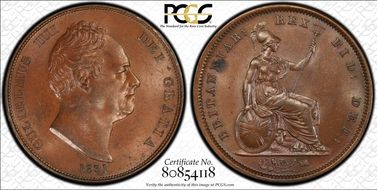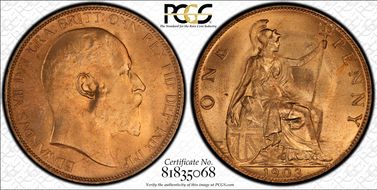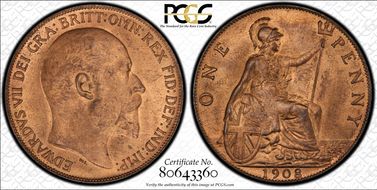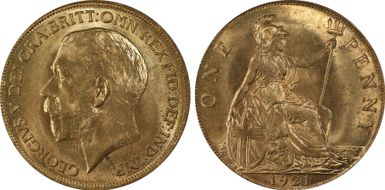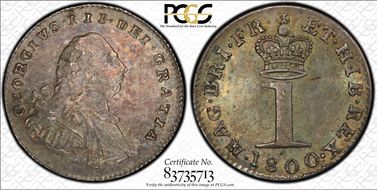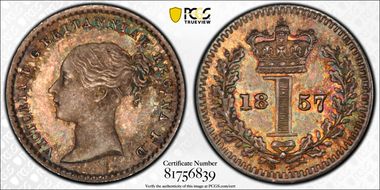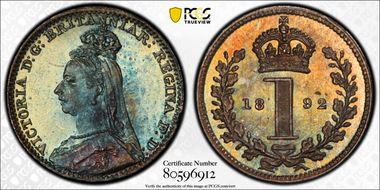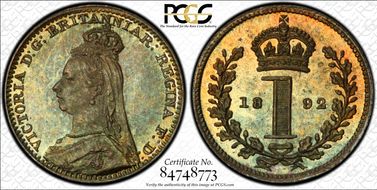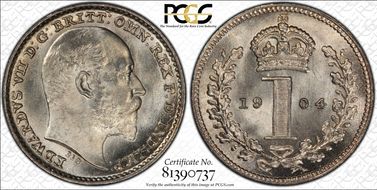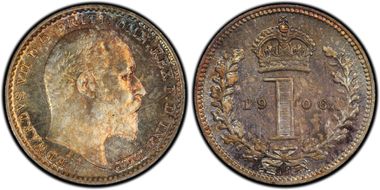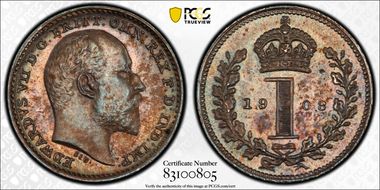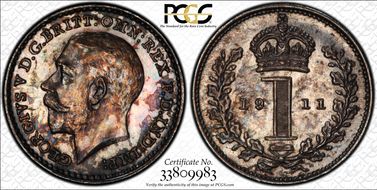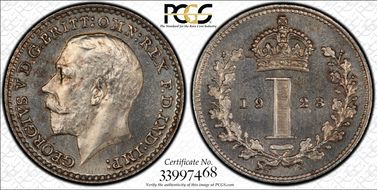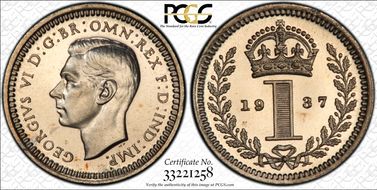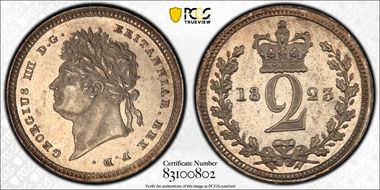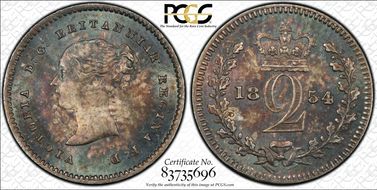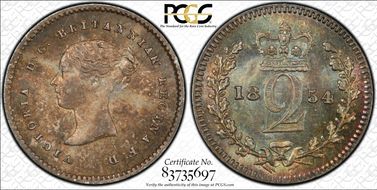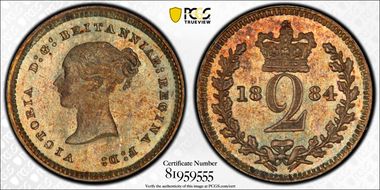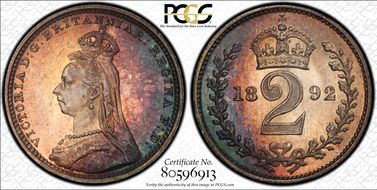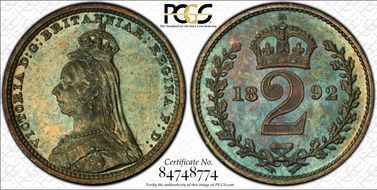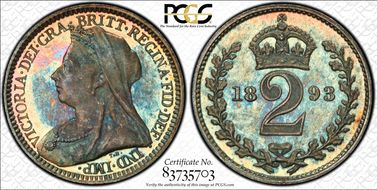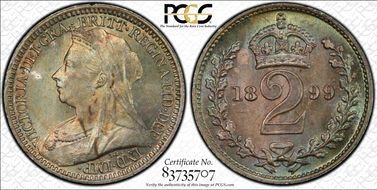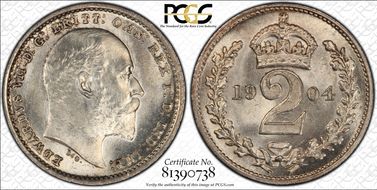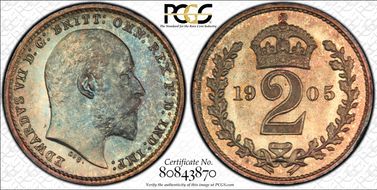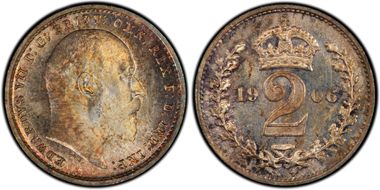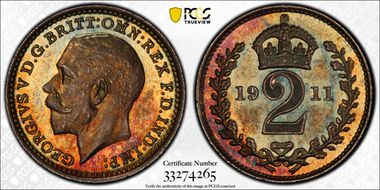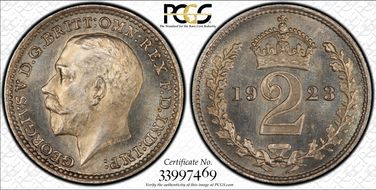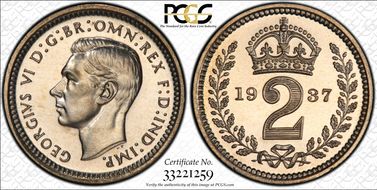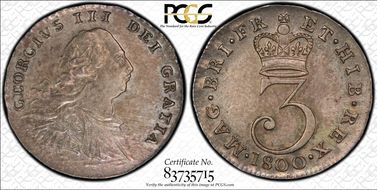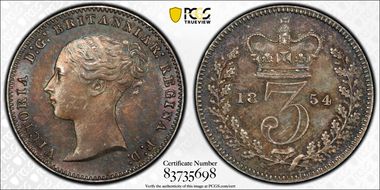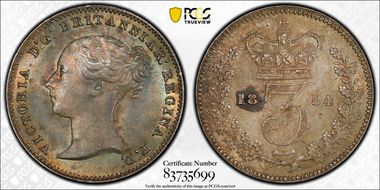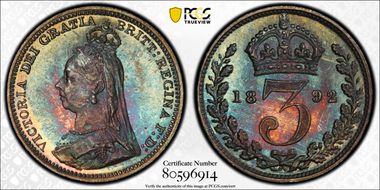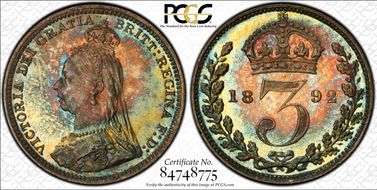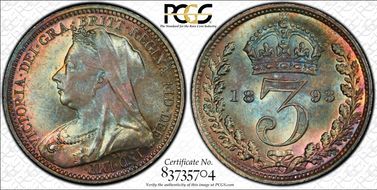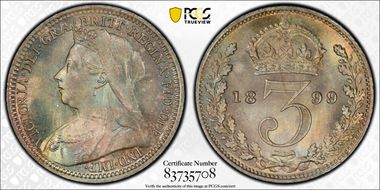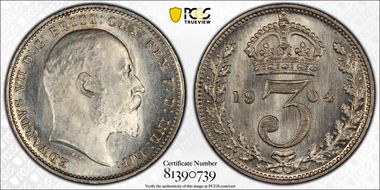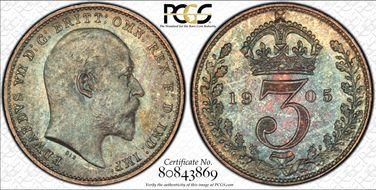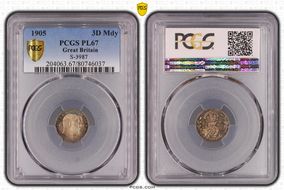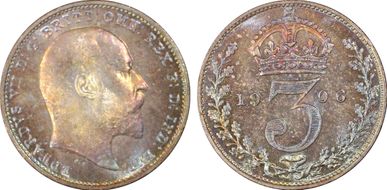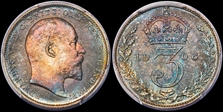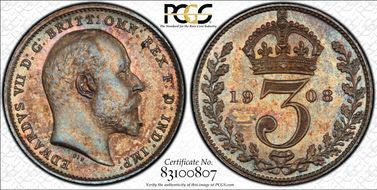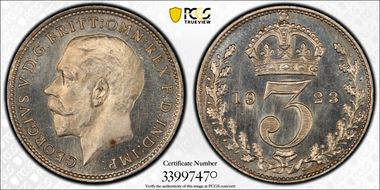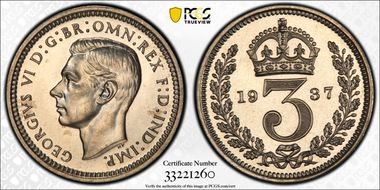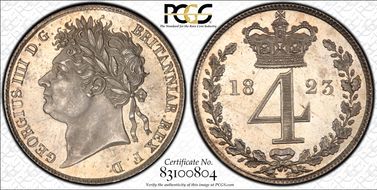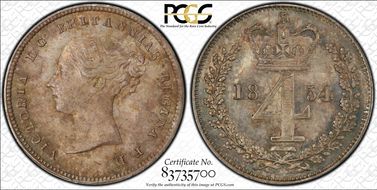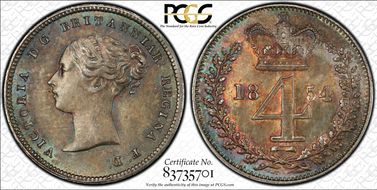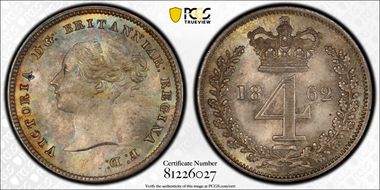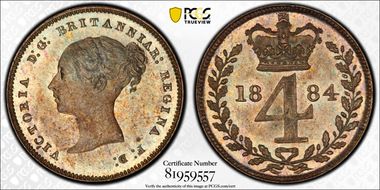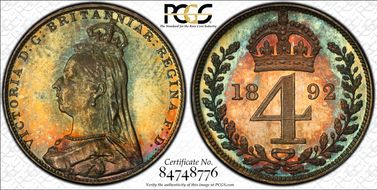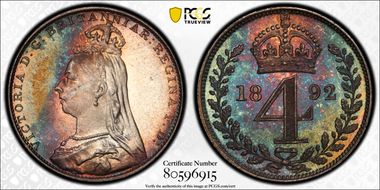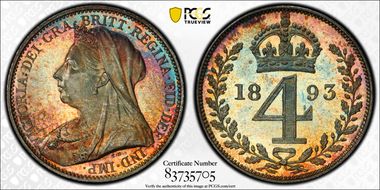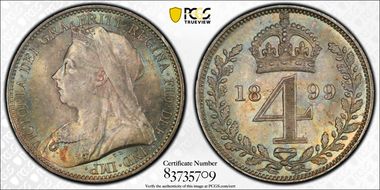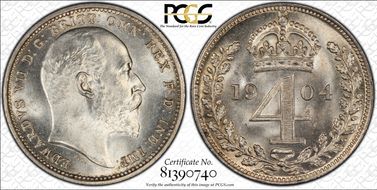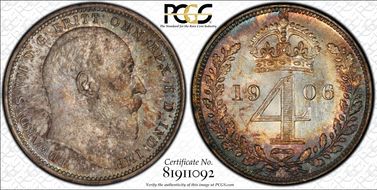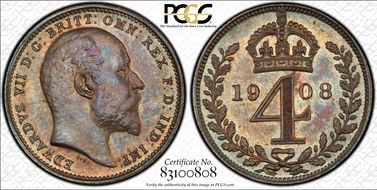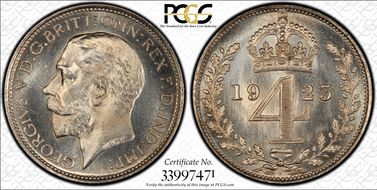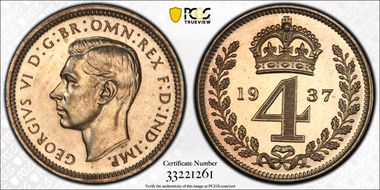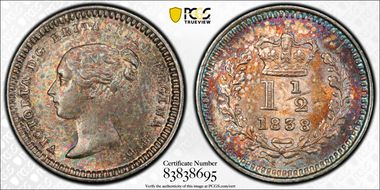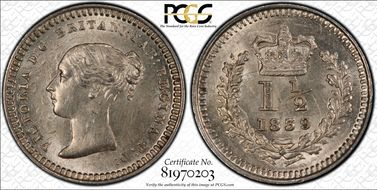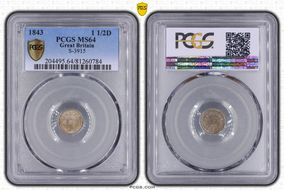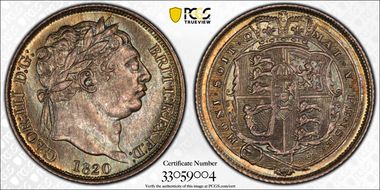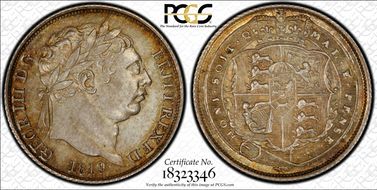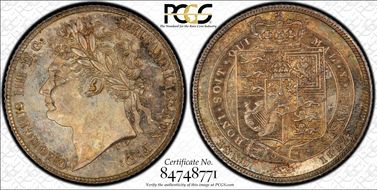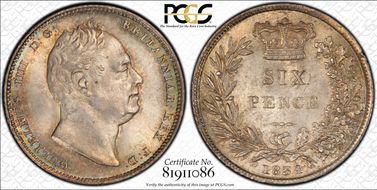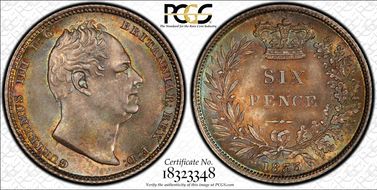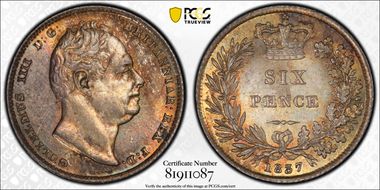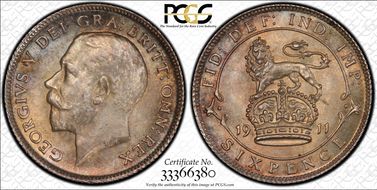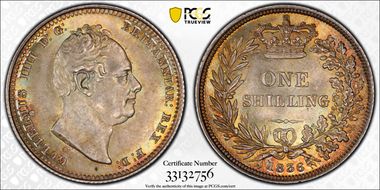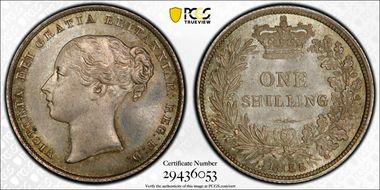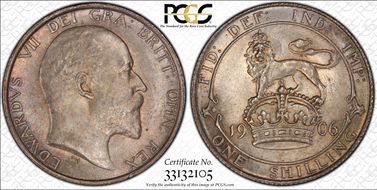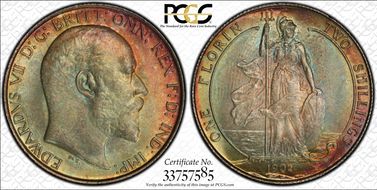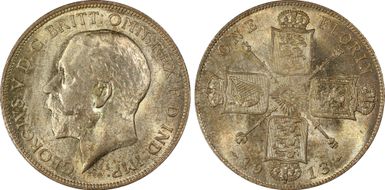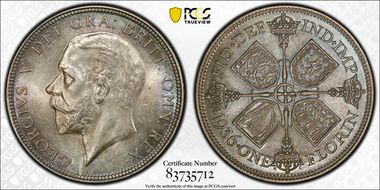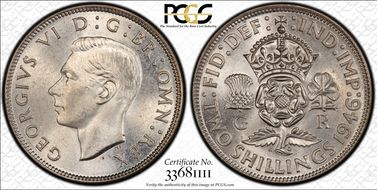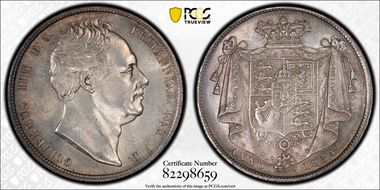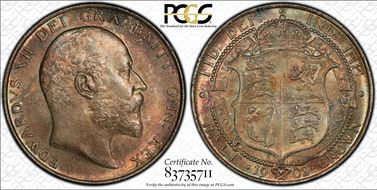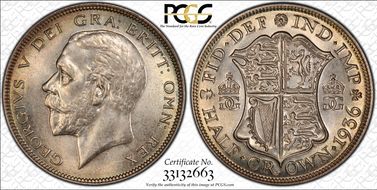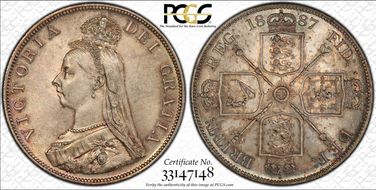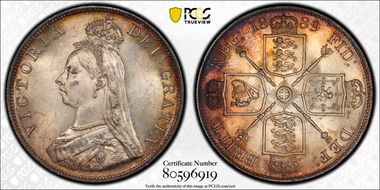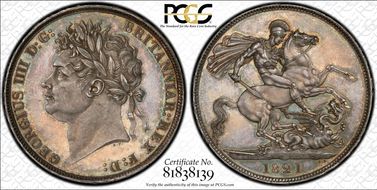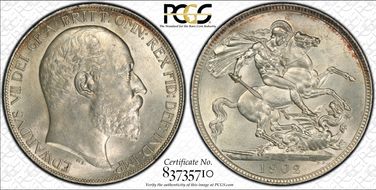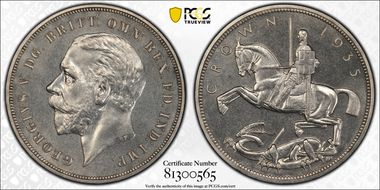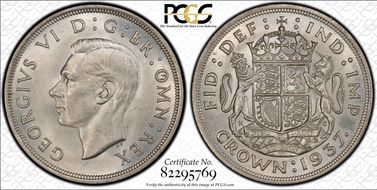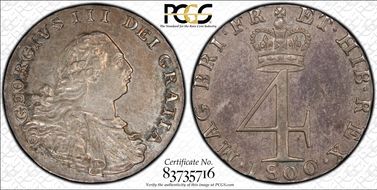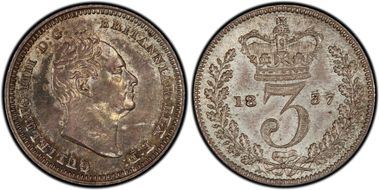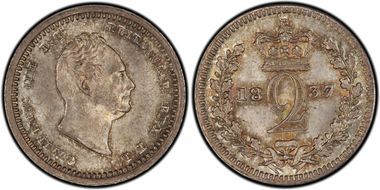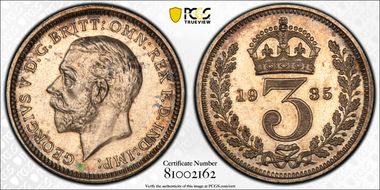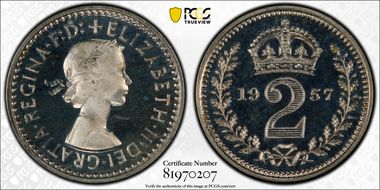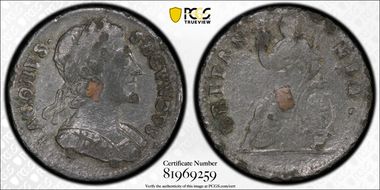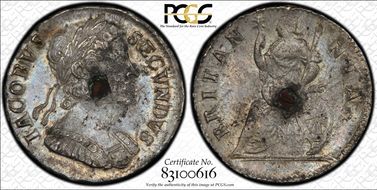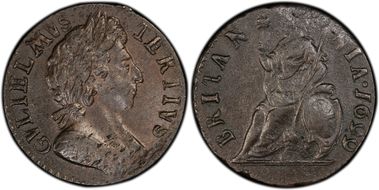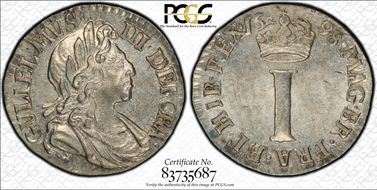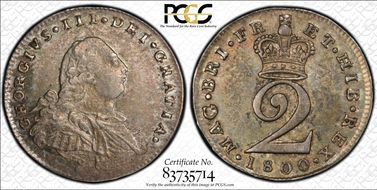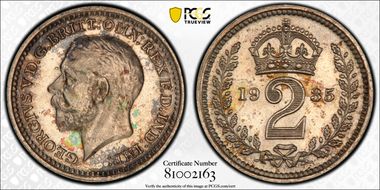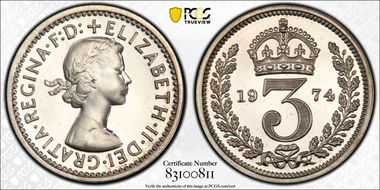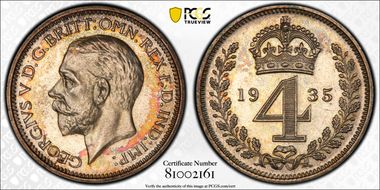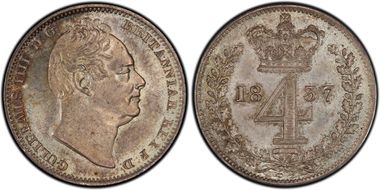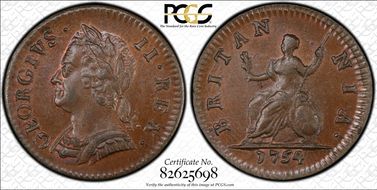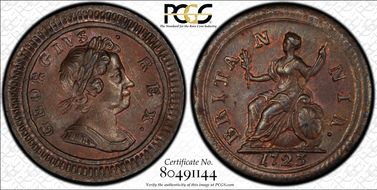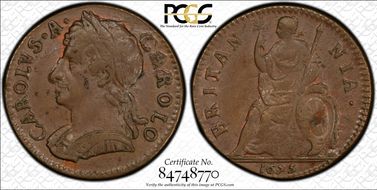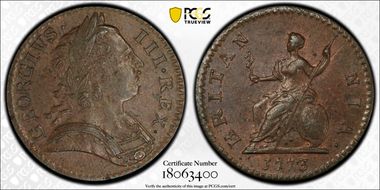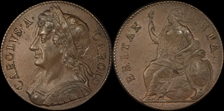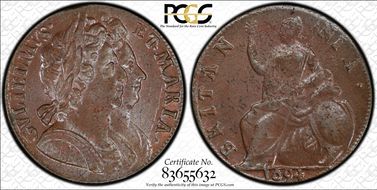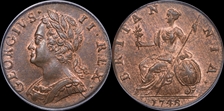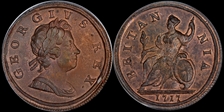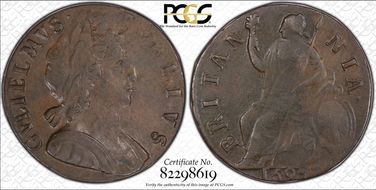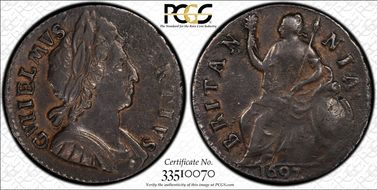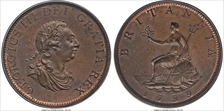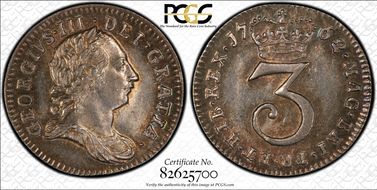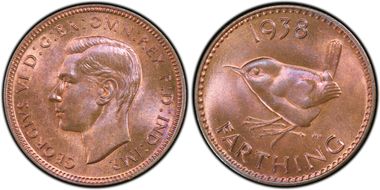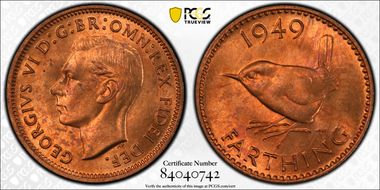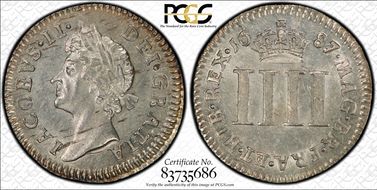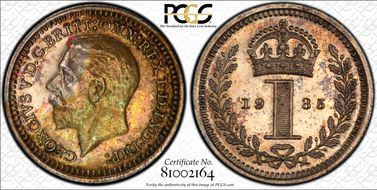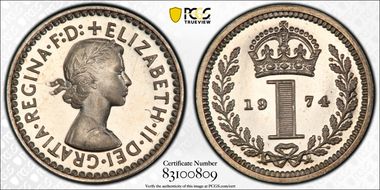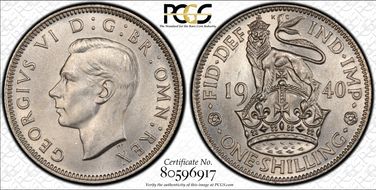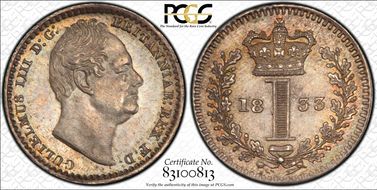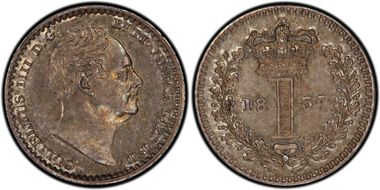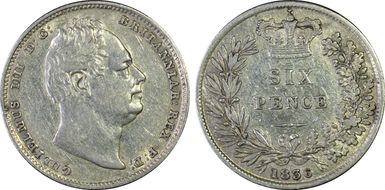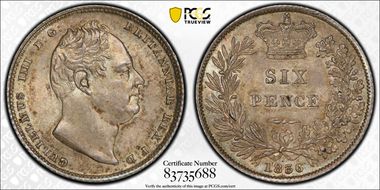Azlarry 的钱币相册
(1866) Very difficult to find gem George VI sixpences. This is one of onlythree graded for entire series. From the Cambridge Gate Collection.
(1866) Very difficult to find gem George VI sixpences. This is one of onlythree graded for entire series. From the Cambridge Gate Collection.
(1994) Nice strike on this tiny coin, light wear on wreath, hair and crown. Light champagne tone on obverse and reverse.
(1836) Very well struck with good detail. Nice luster with great color.
(1836) Very well struck with good detail. Nice luster with great color.
(1617) Blazing red luster on very clean surfaces for a George VI coin. Purchased raw, self-submitted.
(1617) Blazing red luster on very clean surfaces for a George VI coin. Purchased raw, self-submitted.
(1663) A fresh halfpenny with much luster and color bloom. Purchased raw, self submitted.
(1622) Nice rose tint on clean surfaces. Purchased raw, self submitted.
(1927) Much red around the devices.Attractive one year type.
(1971) This is a one year type intended for tax revenues on the island of Malta thus choice gem are not often encountered. A superior strike, with glossy luster and plenty of red on both reverse and obverse.
(1928) Hard to find one year type. good strike for the type with even brown surfaces.
(1909) Nice strike, made from an older die. Carbon spotson fairly clean surfaces.
(1914) Hard little coin to find, only two others graded in MS.
(1892) Spectacular strike, PL red surfaces. Only 1 other Victoria 1/3 farthing hit MS66RD
(1907) Nice strike, red surfaces with spotting on obverse. Deep clash marks on reverse.
(1858) Attractive fractional, plenty of luster.Cambridge Gate Collection.
(1908) Above average strike. Red surfaces, with usual spotting. Very little tone.
(1946) One year type with luster and typical red brown surfaces.
(1947) One year type and the last 1/3 farthing ever produced.
(1956) Abundant lust with very red surfaces. Only one graded higher for series.
(2029) Good strike with brown surfaces with zero corrosion or pits which is unusual for the issue. This coin is very hard to find, only 5 have been graded at PCGS with only one of them being MS. The half farthing had a value of 1/1920 to a pound sterling. This denomination was issued for Ceylon and was required to meet daily commercial and tax transactions.
(1857) Nice hair detail, pastel/mauve looking color. Cambridge Gate Collection.
(1857) Nice hair detail, pastel/mauve looking color. Cambridge Gate Collection.
(1578) Great detail from a solid hit, red tone around the peripheries. Peck 1409, S-3822. Mintage 5,924,352.
(1764) Nice brownish-blue color.Peck 1412, S-3822. Mintage 2,365,440. Formerly in a NGC MS66BN holder.
(1764) Nice brownish-blue color.Peck 1412, S-3822. Mintage 2,365,440. Formerly in a NGC MS66BN holder.
(1732) Very common coin in a most uncommon grade; Wonderful green toning on clean surfaces. Peck 1414, S-3822. Mintage 4,300,800.
Atlas (1854)Nicely struck and almost spot free. Much luster under reddish-brown surfaces.
(1758) Peck 1442, S-3823. Mintage 2.365,440. Formerly in a NGC MS64BN Holder.
(1758) Peck 1442, S-3823. Mintage 2.365,440. Formerly in a NGC MS64BN Holder.
(1709) Nice hair detail on obverse. Nice red-orange color on clean surfaces. Peck 1443, S-3823. Mintage 2,365,440. Self Submitted. Very nice orange/red surfaces on obverse.
(1585) Well struck Gem for the key date of George IV farthings. Peck 1444, S-3823. Mintage 1,505,280. Formerly in a NGC MS65BN holder.
(1710) Nice sharp strike. Peck 1445, S-3825. Mintage 2,365,440. Self Submitted
(1587) Nice brown color, typical gap in the "3" in date. Peck 3848, mintage 2,688,000.
(1587) Nice brown color, typical gap in the "3" in date. Peck 3848, mintage 2,688,000.
(1761) Good tone and eye appeal, shows good strike detail for a MS63 coin. Formerly in a NGC MS62BN holder.
(1761) Good tone and eye appeal, shows good strike detail for a MS63 coin. Formerly in a NGC MS62BN holder.
(1961) Of all William IV farthings graded this is the only one to receive a MS65. Unusually solid strike, clean surfaces, and plenty of red around the devices.
1523) Well struck, clean surfaces and a hint of blue tone. A very hard farthing to find in 64, like all William IV farthings.
1523) Well struck, clean surfaces and a hint of blue tone. A very hard farthing to find in 64, like all William IV farthings.
(1760) Nice color with good detail, many hits drag it down to MS63BN level. Crossed in a NGC holder.
(1760) Nice color with good detail, many hits drag it down to MS63BN level. Crossed in a NGC holder.
(2023) As expected from a MS66 a very sharp strike with good detail on both sides of the coin. Very nice red color with minor spotting, very few marks or scuffs on the surface..
(1869) Great luster and red color on this gem. Bold large date and well struck details.
(1869) Great luster and red color on this gem. Bold large date and well struck details.
(1840) full strike, even chocolate brown surfaces. Lots of luster with some minor spotting.
(1957) Sensational looking halfpenny. Standout strike, bright red surfaces
(1917) Deep Red, clean surfaces. Only 1909 1/2 d to be graded RED.
(1624) Boldly struck gem, flashy surfaces with brownish-red-blue surfaces.Only two other George V halfpennies have reached MS66, 2 RB and 1 RD. Purchased raw, Self Submitted
(1624) Boldly struck gem, flashy surfaces with brownish-red-blue surfaces.Only two other George V halfpennies have reached MS66, 2 RB and 1 RD. Purchased raw, Self Submitted
(1995) Obverse well struck with clean surfaces and plenty of red. Reverse show very little red and scuffing to front and back of Britannia.
(1949) Crisp strike with good hair detail. Red/green toning with fairly clean surfaces, minor spotting.
(1951) Difficult coin type to find. Smooth chocolate brown color. Few ticks to surfaces but carbon spotting, especially on reverse.
(1973) Razor sharp strike with minimal marks to surface. Nice Red patina with much eye appeal
(1973) Razor sharp strike with minimal marks to surface. Nice Red patina with much eye appeal
(2027) A common type in general, but quite scarce at this level of preservation. At PCGS this is the only King Edward VII Penny to reach MS66RD. An abundant amount of golden red luster and a very sharply struck.
(1926) Full mint brilliance. Great eye appeal for a Eward VII penny.
(1864) Very bright with copper/red color and very lustrous surfaces. Cambridge Gate Collection.
(1967) Very evenly matched original Maundy set. All four coins have sharp strikes with light silver-gold tonning with reflective luster.
(1996) Nice gem strike with colorful greenish patina on surfaces.
(2000) Well struck with good detail on obverse and reverse. Clean surfaces with champagne and greenish patina.
(1942) Nice matched original set. Each coin has satiny luster showing varying degrees of vivid golden-orange tones.
(1875) Blue-Orange-Gold colors. Solid hit with luster under tone.
(2004) A nicely matched set all grading MS66 to MS67+. Original surfaces slightly proof like, with multi colored iridescent toning. 88
(2019) Evenly gem matched set all with proof like colorful tone and underlying luster.
(1975) A very nice Maundy set with all coins grading PL66 to PL67+. Beautifully toned with vivid sea green and champagne colors. Looks like an original well matched set.
(1888) Very unusual Edward VII maundy set as there is very little tone on any of the coins.
(1902) Nice matching set with golden-blue-gray iridescence toning. Strike and clean surfaces typical of MS67-68 coins.
(1962) a original matched set with PL surfaces and nice toning.
(1968) Very evenly matched original Maundy set. All four coins have sharp strikes with light silver-gold tonning with reflective luster.
(1997) Good detail showing from a descent strike. Green patina, obverse and reverse.
(2001) Super strike with much detail. Obverse muted patina with a X showing Maundy case ties. Reverse vibrant green-orange toning, the 8 and 4 have been recut.
(1943) Nice matched original set. Each coin has satiny luster showing varying degrees of vivid golden-orange tones.
(1876) Wonderful mauve-blue tone. Few scuffs on obverse keeps from a MS67 grade.
(2005) A nicely matched set all grading MS66 to MS67+. Original surfaces slightly proof like, with multi colored iridescent toning.
(2020) Evenly matched set all with proof like colorful tone and underlying luster.
(1976) A very nice Maundy set with all coins grading PL66 to PL67+. Beautifully toned with vivid sea green and champagne colors. Looks like an original well matched set.
(1889) Very unusual Edward VII maundy set as there is very little tone on any of the coins.
(1911) Blueish obverse, golden reverse. Nice luster under tone.
(1903) Nice matching set with golden-blue-gray iridescence toning. Strike and clean surfaces typical of MS67-68 coins.
(1963) a original matched set with PL surfaces and nice toning.
(1969) Very evenly matched original Maundy set. All four coins have sharp strikes with light silver-gold tonning with reflective luster.
(1944) Nice matched original set. Each coin has satiny luster showing varying degrees of vivid golden-orange tones.
(2006) A nicely matched set all grading MS66 to MS67+. Original surfaces slightly proof like, with multi colored iridescent toning.
(2021) Evenly matched set all with proof like colorful tone and underlying luster.
(1977) A very nice Maundy set with all coins grading PL66 to PL67+. Beautifully toned with vivid sea green and champagne colors. Looks like an original well matched set.
(1890) Very unusual Edward VII maundy set as there is very little tone on any of the coins.
(1904) Nice matching set with golden-blue-gray iridescence toning. Strike and clean surfaces typical of MS67-68 coins.
(1904) Nice matching set with golden-blue-gray iridescence toning. Strike and clean surfaces typical of MS67-68 coins.
(1964) a original matched set with PL surfaces and nice toning.
(1970) Very evenly matched original Maundy set. All four coins have sharp strikes with light silver-gold tonning with reflective luster.
(1954) Fully struck with clean original surfaces. Sea green silvery gold tone.
(1945) Nice matched original set. Each coin has satiny luster showing varying degrees of vivid golden-orange tones.
(1878) Rainbow toning with great eye appeal. Spectacular hit make it a pop 1/0 at PCGS.
(2007) A nicely matched set all grading MS66 to MS67+. Original surfaces slightly proof like, with multi colored iridescent toning.
(2022) Evenly matched set all with proof like colorful tone and underlying luster.
(1978) A very nice Maundy set with all coins grading PL66 to PL67+. Beautifully toned with vivid sea green and champagne colors. Looks like an original well matched set.
(1891) Very unusual Edward VII maundy set as there is very little tone on any of the coins.
(1913) Super gem coin with multi colored tone on clean surfaces. Top pop 1/0 at PCGS.
(1905) Nice matching set with golden-blue-gray iridescence toning. Strike and clean surfaces typical of MS66-68 coins.
(1965) a original matched set with PL surfaces and nice toning.
(2034) Reflective surfaces throughout, iridescent purple, blue, orange, and gold patina makes this little coin very appealing.
(1955) Unusually well struck for this tiny coin. Clean surfaces with orange-blue tone.Only Victoria 1 1/2 pence to reach MS66, only one other at MS65.
(1972) Asuper gem with full mint bloom. Light blue and amber patina, great eye appeal.
(1972) Asuper gem with full mint bloom. Light blue and amber patina, great eye appeal.
(1516) ESC-1630. Mintage 10,921,680 (includes all 6d minted in 1816 and 1817). Formerly in a NGC MS66 holder. A spectacular looking 6 d.
(1516) ESC-1630. Mintage 10,921,680 (includes all 6d minted in 1816 and 1817). Formerly in a NGC MS66 holder. A spectacular looking 6 d.
(1717) Fully struck with no discernible marks. Very lusterous surfaces under blue-green tone. Exeter College Collection.
(1685) S-3791, ESC-1636. Mintage 4,712,400. This is a 1819/8 variety. Housed in an old green holder.
(1685) S-3791, ESC-1636. Mintage 4,712,400. This is a 1819/8 variety. Housed in an old green holder.
(1599) Nice strike for the grade showing some weakness in the centers. Obverse has very clean surfaces while the reverse shows a few bag marks and light scuffing. Nice greenish-gold tone on the peripheries. Over all a very attractive sixpence.
(1763) A very tough coin to find, as are most 1837 dated coins of King William IV. Very strong strike on the reverse, shows weakness on the obverse do to excessive wear in the die. Very nice greenish-orange tone which gives this coin nice eye appeal. There are several "slide marks" on the forehead and brow and I believe these are as minted. The other PCGS 1837 sixpence graded MS64 has similar marks like this on the obverse.
(1861) Nice eye appeal with gold, green and red toning. 67 worthy technical merit. CambridgeGate Collection.
(1863) Totally hammered from fresh dies. Reverse looks newly sculptured. CambridgeGate Collection.
(1863) Totally hammered from fresh dies. Reverse looks newly sculptured. CambridgeGate Collection.
Atlas (1855) Nicely struck with golden orange toning on original surfaces.
(1865) Well struck with a full lion's face. Good luster under attractive toning. CambridgeGate Collection.
(1950) Sea green and champagne toning. Very close to unblemished surfaces.
(1883) A technical gem, about fully struck, with clean surfaces. There is a significant amount luster with light toning on the edges.
(1883) A technical gem, about fully struck, with clean surfaces. There is a significant amount luster with light toning on the edges.
(1896) Cartwheel luster with amber-gold iridescent toning. The lion's face has almost full detail.
(1821) Reverse nicely toned a silvery gray and the obverse satiny with pinkish golden green pastel iridescence.
(1862) Good strike and luster, wonderful eye appeal. CambridgeGate Collection.
(1862) Good strike and luster, wonderful eye appeal. CambridgeGate Collection.
(1983) Russet champagne and greenish gold iridescent toning on mark free surfaces. Much glossy luster under the tone that the image does not show properly. Good heavy strike that shows much detail for the issue. The only reason this did not grade higher is because of finger prints.
(1983) Russet champagne and greenish gold iridescent toning on mark free surfaces. Much glossy luster under the tone that the image does not show properly. Good heavy strike that shows much detail for the issue. The only reason this did not grade higher is because of finger prints.
(2012) Fully struck with fairly clean surfaces despite a few hits in the fields. Delicate greenish-champagne tone showing much luster.
(1844) Very difficult to find a George VI Florin in MS65 there are only 2 other Gems in the entire Florin series, and none higher.
(1960) Made from well worn obverse and reverse dies. Nice periphery color, clean surfaces.
(1895) True gem strike with clean surfaces and gold-orange tone.
(2009) Boldly struck with sharp hair details. Original surfaces with polychromatic toning on both sides.
(1872) Well struck, true GEM with clean,lightly toned surfaces. None graded higher. ESC3354
(1897) Boldly struck with mark free surfaces. Cartwheel luster with light golden-orange toning. Nicest George V halfcrown I have ever owned.
(1843) Well struck, very nice even luster. Very few marks on obverse, which is unusual for a George VI coin.
(1894) Well struck with very few marks for a double florin. Nice luster with multi color tone.
(2027) Clean poof like surfaces with even blueish gray patina. Solid strike, sharply defined details throughout on obverse and reverse. Edge impressed with "Secundo" which designates the second year of the reign of King George IV.
(2027) Clean poof like surfaces with even blueish gray patina. Solid strike, sharply defined details throughout on obverse and reverse. Edge impressed with "Secundo" which designates the second year of the reign of King George IV.
(1849) Very solid hit with few surface marks. Nice steel tonning with royal blue and gold high lights.
(2008) Close to a MS64 strike, with silvery-champagne toning enhanced by strong luster.
(1952) Solid strike, good luster on silvery toned surfaces. Crossed in a NGC MS64 holder.
(1974) Full mint luster, with a hint of golden tone. Surfaces are free of noticible marks and the fields are reflective.
(2013) Surprisingly well struck for this issue, no bag marks with only minor surface abrasions. booming luster, with very light silvery toning, nice eye appeal.
(1940) well matched set with strong proof like surfaces with cameos.
(1798). A very nice Gem sixpence. Well struck both sides, nice tone with little if any tin flecks.
(1798). A very nice Gem sixpence. Well struck both sides, nice tone with little if any tin flecks.
(1899) Clean surfaces with few marks. William IV Maundy coins are very hard to find in Uncirculated condition.
(1939) well matched set with strong proof like surfaces with cameos.
(1980) Good strike, good luster nice Maundy set. Bought raw, self made.
(1920) Several small corrosion spots typically seen on early tin farthings. Visible copper plug was used to foil counterfeiters.
(1966) Amazing thing about this always crude, copper plugged farthing are the clean surfaces. There is actual luster with blue and gold iridescence on obverse and reverse of this farthing, with relatively few tin "pests". This is the only James II farthing that I have seen with luster and pleasing patina, very surprising. James II farthings were issued in 1684 and 1685, this is the only one to be graded MS at PCGS.
(1819) Pleasing chocolate brown surfaces with minor flecking. Solid hit on obverse, reverse shows loss of detail to britannia's head due to an inferior blank, typical for the Royal Mint at this time.
(1993) A true Gem strike with sharp details on obverse and reverse. Surfaces are clean or bright original luster. A true Gem with great eye appeal.
(1991) Made from a well worn and crumbling die. Despite the condition of the die this is a nice representation of a Charles II twopence.
(1873) Wonderful tone, one of only 5 shillings in entire series to make MS65, none graded higher. Purchased raw, self made.
(1582) Only one other 6D graded in MS in 1944. Tough year for George VI coins.
(1981) Good strike, good luster nice Maundy set. Bought raw, self made.
(1941) well matched set with strong proof like surfaces with cameos.
(1982) Good strike, good luster nice Maundy set. Bought raw, self made.
(1901) As with the other coins in this well matched set we have nice blue-gray iridescent toning on top of original mark free surfaces.
(1716) Old bust, solid for the grade with a little rub on portrait.
(2035) A crisp strike from slightly old dies exhibiting a little rust. Reflective chocolate brown surfaces with traces of red around the devices. This is the most common farthing of the period, but at MS65 there are only two others graded higher.
(1906) Struck from a full flan with excellent obverse rims. Nice chocolate brown surfaces with a little mint red around the devices. The dies are slightly worn but do not exhibit any rust, which was common in this era.
(1708) Nice strike with 80% detail on Britannia's face. Nice chocolate-brown color.Removed from a NGC MS64BN holder.
(1708) Nice strike with 80% detail on Britannia's face. Nice chocolate-brown color.Removed from a NGC MS64BN holder.
(1937) Glossy chocolate brown surfaces with traces of red on outer letters. Die clashing on obverse, but no distracting handling marks. Straight rims, softly struck on obverse head area and on the reverse in the date area.
(1937) Glossy chocolate brown surfaces with traces of red on outer letters. Die clashing on obverse, but no distracting handling marks. Straight rims, softly struck on obverse head area and on the reverse in the date area.
(2037) Conjoined busts of William and Mary as joint monarchs. This half penny which can be found in lower grades is rarely seen in mint state. The coin is exceptionally lustrous and original with a hint of mint red and a glossy sheen. The reverse is weakly struck and spotty as is always seen on this type. On the obverse the portraits are sharp and remarkable.
(1839) A glossy old bust halfpenny which contains considerable mint red luster. Good portrait of the King despite the numerous die-breaks on the obverse die.
(1834) The "dump issue" was issued for only three years. A solid strike from rust free dies, all the lettering is crisp and not doubles. An exceptional portrait and sharp Britannia. Glossy brown surfaces with plenty of mint red around the devices. There is a flan flaw on the rim between the E and X in REX.
(1834) The "dump issue" was issued for only three years. A solid strike from rust free dies, all the lettering is crisp and not doubles. An exceptional portrait and sharp Britannia. Glossy brown surfaces with plenty of mint red around the devices. There is a flan flaw on the rim between the E and X in REX.
(2036) Especially choice with a near gem strike. Strong hard luster with gold iridescent toning.
(1612) Nice red luster on clean surfaces. Purchased raw, self submitted.
(1838) Bold strike with a very good portrait and strong reverse details. Lustrous surfaces with rose-champagne patina, few marks and little tin flecking.
(1818). Nice greenish tone, true Gem strike. S-3749 The Skipton Castle Collection.
(1818). Nice greenish tone, true Gem strike. S-3749 The Skipton Castle Collection.
(1959) Colorful little silver coin. A descent strike, but the scuffs on obverse reduces the grade.
(1992) A well struck 4D with an exceptional portrait of King James II . Light silvery-golden tone over glossy luster, minor flecking to the obverse, light milling marks on the reverse.
(1938) well matched set with strong proof like surfaces with cameos.
(1979) Good strike, good luster nice Maundy set. Bought raw, self made.
(1916) Nice strike, few contact marks on obverse. Purchased raw self made.
(1985) A gem strike with excellent detail. Original surfaces with attractive with golden blue gray patina. Nice to have a King William IV maundy coin graded in gem condition.
(1990) As with the 1837 6d, the 1836 is a very hard coin to find in any grade. Sharply struck with good hair detail, the reverse has pin point detail. Surfaces are clean with goldish toning.




















